Hey there, fellow dog lover! 🐾 If you’ve ever found yourself standing in the pet care aisle, staring at nail grinders and clippers and wondering which tool is the knight in shining armor for your dog’s nails, you’re not alone. Keeping our furry friends’ nails trim isn’t just about aesthetics; it’s crucial for their health and comfort too. But with two main tools on the market, each flaunting its own set of perks, the decision isn’t always straightforward. Whether you’re a seasoned dog parent or a first-timer looking to venture into the world of pet grooming, our in-depth look at dog nail grinders vs. clippers aims to break down the pros and cons and give you the insights you need. Let’s embark on this nail-trimming journey together and find the perfect fit for your pup’s pedicure! 🐶✂️🔧
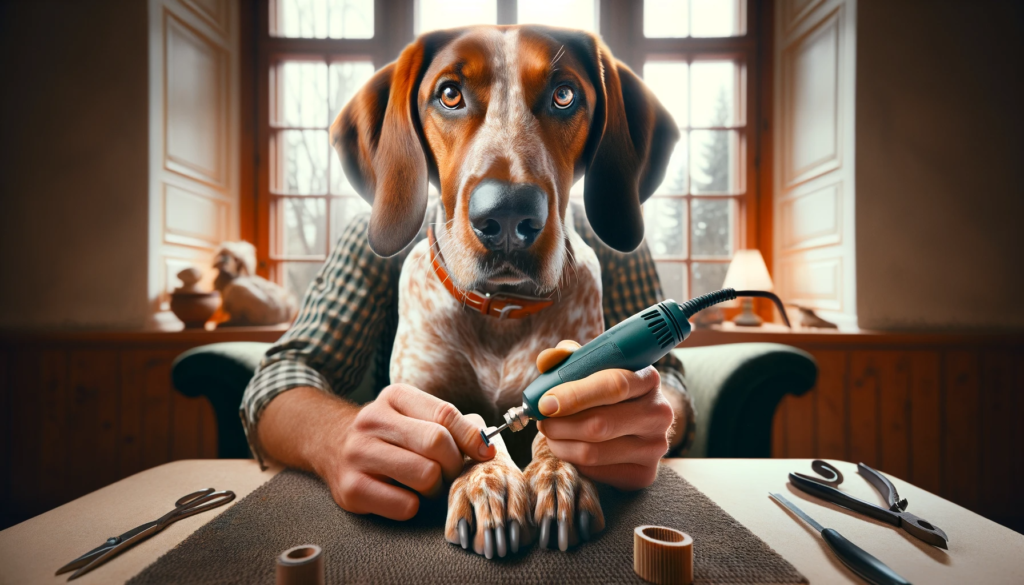
What is a Dog Nail Grinder?
Ever watched a cat or a dog naturally file their nails by scratching on a tree or a post? Well, a dog nail grinder is kind of like the high-tech version of that! Imagine a compact, handheld device that looks a little like a mini flashlight, but at its tip, it has a rotating component made of sandpaper-like material.
Instead of snipping off nail pieces like clippers do, a grinder works by, well, grinding down the nail in a more controlled manner. It’s sort of like using a nail file for us humans, but supercharged. The grinder shaves off thin layers of the nail until it’s at the desired length and shape. And just like how we feel fancy after a nail spa day, your pup gets a smooth, rounded edge, ensuring no scratchy encounters post-grooming.
Now, while it might sound a bit space-age if you’re new to the dog grooming game, many groomers and pet parents swear by them. But of course, like all things in life (and especially in pet care), there are pros and cons to using a grinder. Stick around, and we’ll delve into those next! 🐕💅🏼🌌
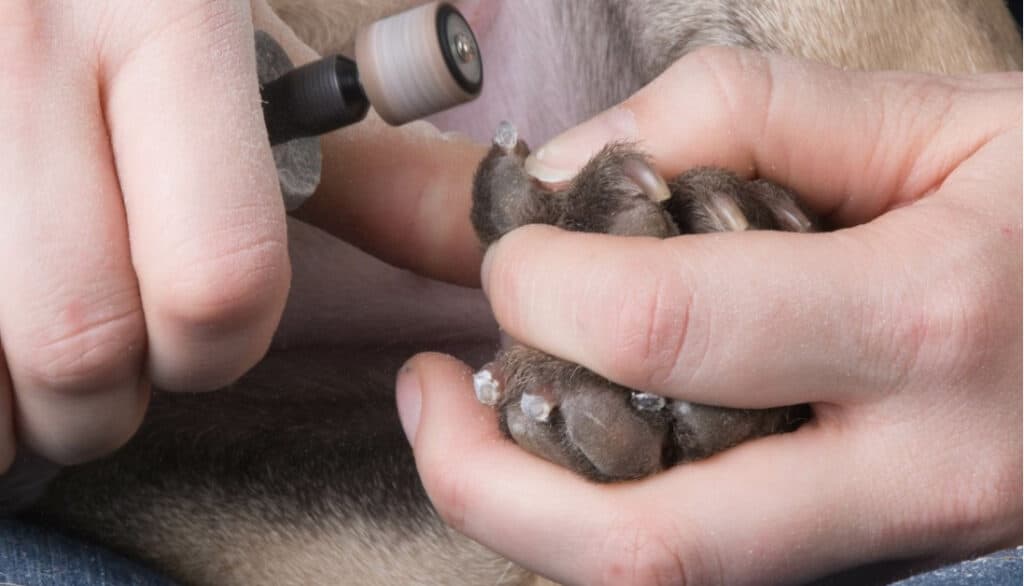
Benefits of Using a Dog Nail Grinder
Ah, the magic of nail grinders! While they may not come with fairy dust, they sure do have some enchanting benefits. Let’s break down why many dog parents and professional groomers have made the switch and are grinding away with glee.
Safety First
- Reduced Quick Risk: If your dog’s nails are dark, it can be tough to see the quick (the sensitive part inside the nail). With grinders, you can approach the quick slowly, reducing the risk of painful accidents.
- Consistent Pressure: Grinders offer consistent pressure, ensuring you don’t apply sudden force that could hurt your pup.
A Smooth Finish
- No Sharp Edges: Grinders leave a rounded nail tip, meaning less risk of scratches on your hardwood floors or your skin.
- Avoiding Nail Splits: Since you’re grinding away gradually, the chances of splitting or fracturing the nail are reduced.
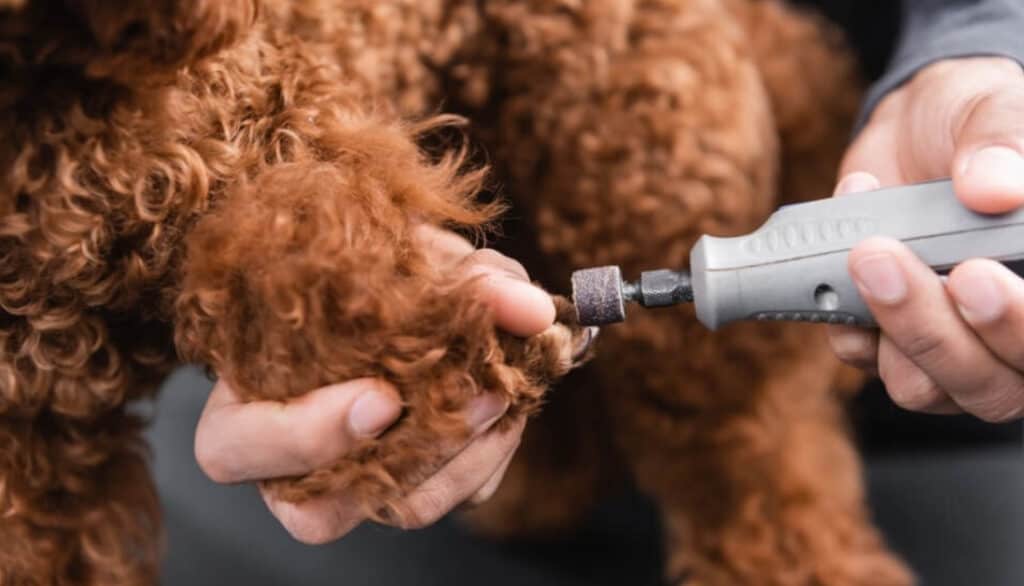
Versatility in Grooming
- Ideal for Thick-Nailed Breeds: Some doggos have nails as sturdy as fortresses! Grinders can handle those nails with ease, whereas clippers might struggle.
- Customizable Grinding Tips: Many grinders come with different grinding tips or adjustable speeds, allowing for a tailored grooming experience.
Gradual & Stress-Reduced Trimming
- Ease Into It: Especially for nervous pets, the gradual process of grinding can sometimes be less intimidating than a single, quick clip.
- Clear Feedback: As you near the quick, your dog might react, giving you feedback to stop grinding, whereas a clipper might not offer that same warning sign.
So, while every dog is a unique furball with individual preferences, grinders come with some pretty persuasive benefits. Remember, it’s all about finding what works best for both you and your four-legged friend! 🐾✨
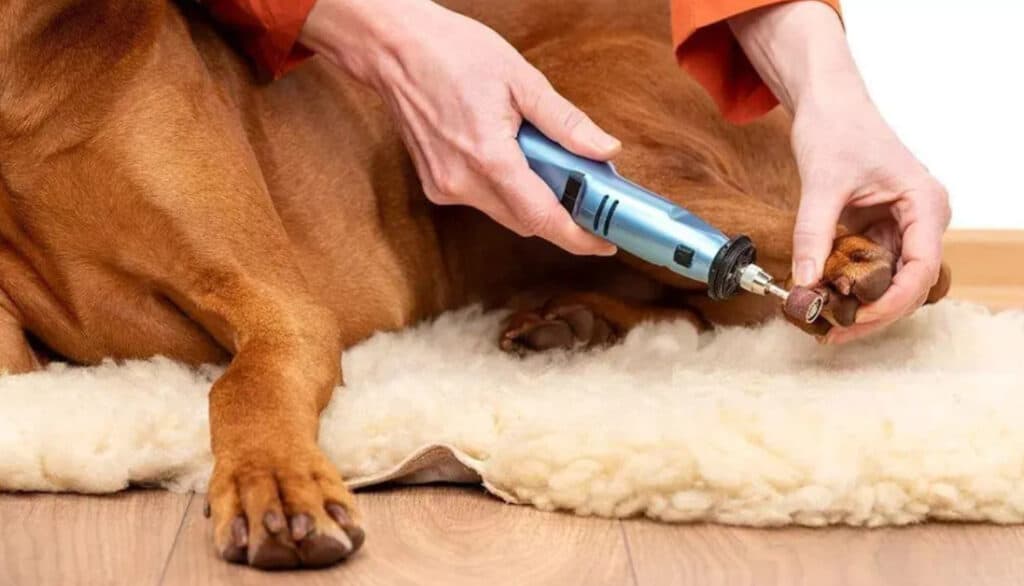
Drawbacks of Using a Dog Nail Grinder
Okay, let’s keep it real: while dog nail grinders come with some fabulous perks, they’re not without their quirks. Just as there are sunny days, there are also occasional rain showers. Let’s chat about the potential drawbacks of using a dog nail grinder.
Noise & Vibration Sensitivity
- The Hum and Buzz: Some dogs are just not fans of the grinder’s noise. That humming sound, even if it’s faint, can be unsettling for our sensitive-eared fur babies.
- Good Vibrations? Not Always: The vibration from the grinder, though slight, can feel odd to your pup, especially if they’re experiencing it for the first time.
The Time Factor
- Patience, Young Padawan: Grinding takes longer than a quick clip. If either you or your pup is the impatient type, this might feel like a tiny eternity.
- Multiple Sessions: For dogs with especially long nails, you might not be able to grind down to the ideal length in one go. This means a few grooming sessions might be in order.
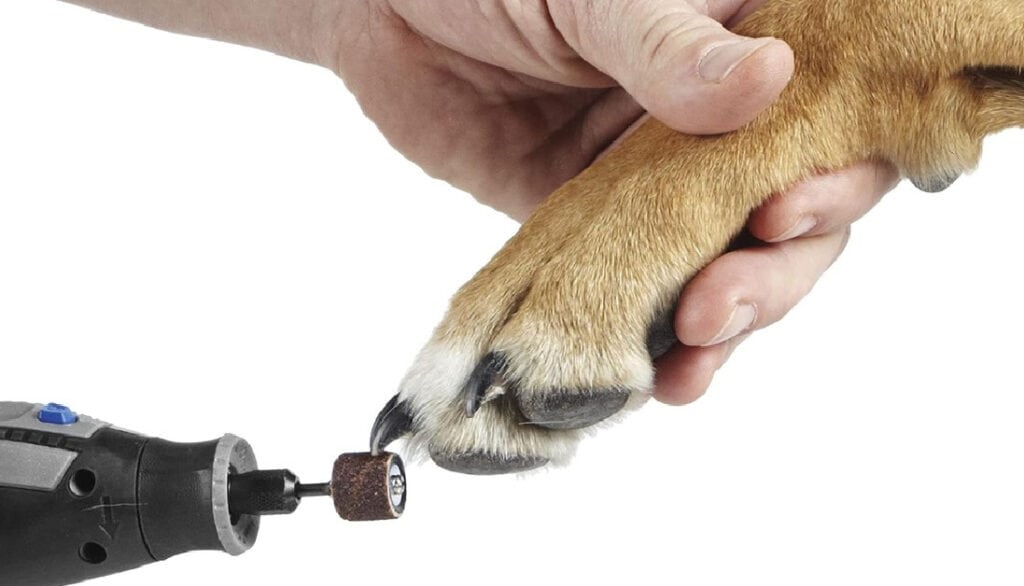
Learning Curve
- New Dog, New Tricks: There’s a bit of a technique to grinding, so it might take a few tries (and possibly some YouTube tutorials) to get the hang of it.
- Finding the Right Grinder: With various brands and models out there, you might need to play Goldilocks until you find the grinder that’s “just right” for you and your pup.
Power Dependency
- Battery Battles: Many grinders are battery-operated. If you forget to charge or replace the batteries, your grooming session could come to an unexpected halt.
- Power Source Hunt: If you opt for an electric grinder, you’re tied to grooming near an outlet, which might not always be convenient.
While these drawbacks can sound a tad daunting, don’t fret! With patience and a sprinkle of understanding, many of these challenges can be navigated or even overcome. After all, every rose has its thorn, right? 🌹🐶🔌

What is a Dog Nail Clipper?
Alright, after that whirlwind tour of nail grinders, let’s shift gears and hop onto the classic train: the trusty dog nail clipper. These bad boys have been around the block and have trimmed more nails than one can count. But if you’re picturing the nail clipper you use on your own fingers, hold up—dog nail clippers have their own unique flair!
Dog nail clippers come in various styles, but the two most common ones are:
- Guillotine Style: Picture a tiny, circular guillotine where you insert the nail. When you press the handles, a blade slides across and trims off the end of the nail. Perfect for smaller breeds, this style offers a quick and clean cut.
- Scissor Type: Resembling a pair of scissors but with specially shaped blades, these are suited for larger dogs with thicker nails. They provide more strength and leverage, ensuring a smooth snip.
Using a nail clipper is pretty straightforward: you position the nail between the blades and apply pressure to clip it. Voila! But, just as with any tool, the secret sauce lies in using it correctly and safely. If you’ve ever felt that twinge of fear imagining snipping too close to the quick, don’t worry, we’ve all been there! It’s all about practice, confidence, and understanding your pupper’s unique nail structure.
And while clippers might seem old school compared to grinders, they’ve earned their stripes (and barks) in the grooming world for a reason. But, just like our grinder chat, let’s also dive into the pros and cons of these veteran tools. Ready, set, snip! 🐕✂️🐾
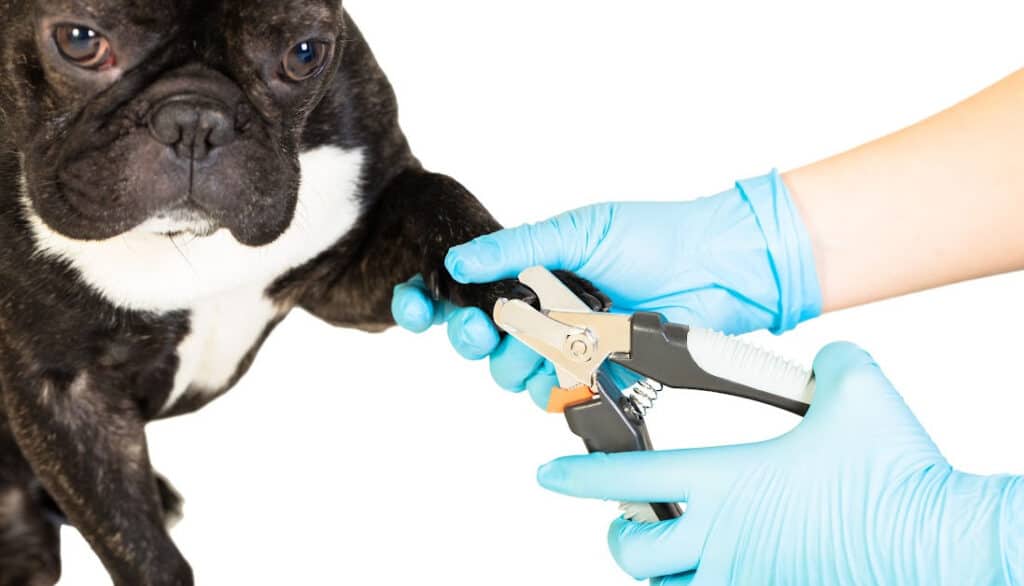
Benefits of Using a Dog Nail Clipper
When it comes to old faithfuls in the grooming arsenal, dog nail clippers definitely earn their spot. Like that favorite pair of jeans or that comfy old t-shirt, there’s a reason they’ve stuck around. Let’s dive into the advantages of these time-tested tools.
Quick and Efficient
- One Snip Wonder: A single, well-placed clip can trim the nail instantly, making the process super quick if you’re confident in your technique.
- Less Fuss: No need to worry about charging or finding an outlet—just grab and snip.
Affordability
- Budget-Friendly: Generally, clippers tend to be less expensive upfront than grinders.
- No Ongoing Costs: Say goodbye to replacing grinding bands or worrying about batteries.
Simplicity in Design
- Easy to Understand: The mechanism is straightforward, making it more approachable for first-timers.
- Compact and Portable: Clippers are lightweight and easy to pack, perfect for travel or on-the-go grooming sessions.
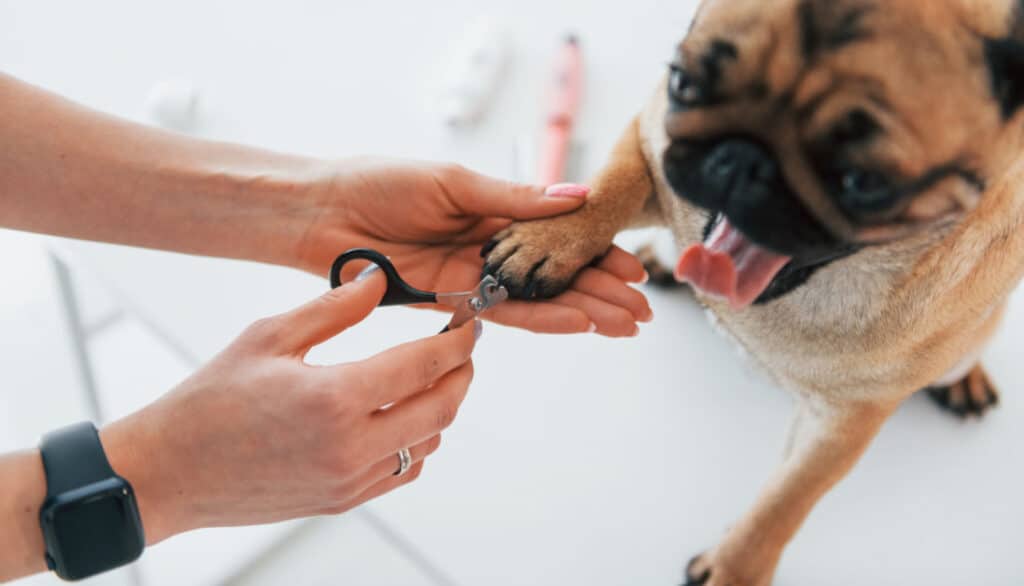
Suitable for Various Nail Types
- Versatile Cuts: With the right type (guillotine or scissor), you can efficiently clip both small and large nails.
- Clean Finish: When used correctly, clippers can provide a neat and tidy finish, with minimal fraying.
Less Sensory Overwhelm
- Silent Operation: Unlike grinders, clippers are quiet, which can be a blessing for dogs sensitive to sound.
- No Vibrations: Without any buzzing or humming, some dogs might find the clipping experience less unsettling.
So, if you’re a fan of the classics or just looking for a no-frills, effective way to keep your dog’s nails in check, clippers might be your go-to. But remember, as with everything in life (and dog grooming), what works wonders for one pooch might not for another. It’s all about finding the right fit and rhythm for you and your furry friend. Happy clipping! ✂️🐕❤️
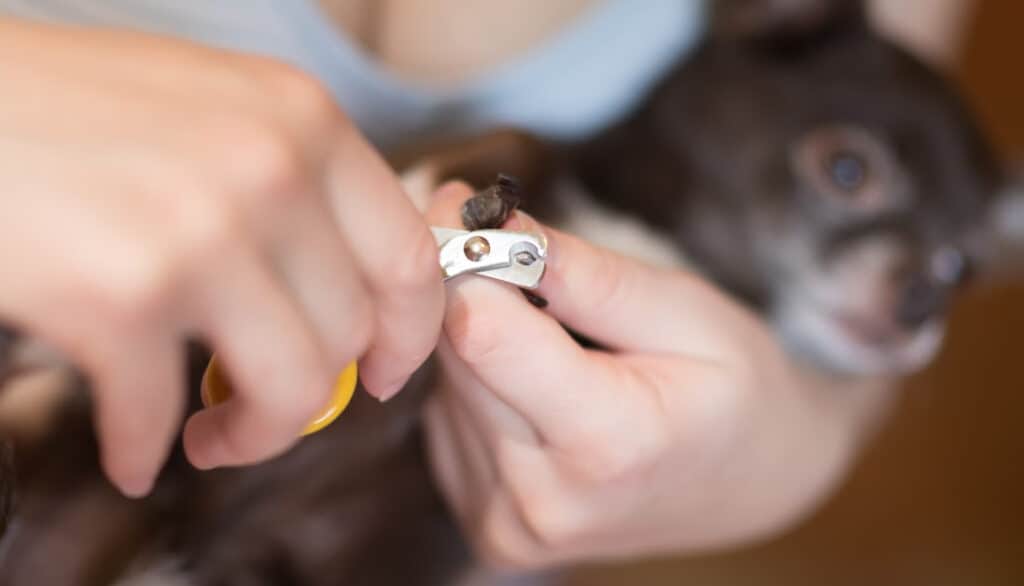
Drawbacks of Using a Dog Nail Clipper
While dog nail clippers might seem like a straightforward choice, it’s not all sunshine and tail wags. As with any tool, there are a few hiccups and challenges you might face. Let’s discuss the potential pitfalls of these traditional trimmers.
Risk of Cutting the Quick
- Oops Moments: Especially with dogs that have dark nails, it can be easy to misjudge and cut into the quick, causing pain and bleeding.
- Steeper Learning Curve: It takes practice (and a steady hand) to perfect the art of clipping without nicks or mishaps.
Potential for Jagged Edges
- Splintering: Clippers can sometimes leave a nail with a jagged or splintered edge, which might require additional filing.
- Nail Splits: If not used correctly, there’s a risk of splitting the nail, which can be painful for your pup.
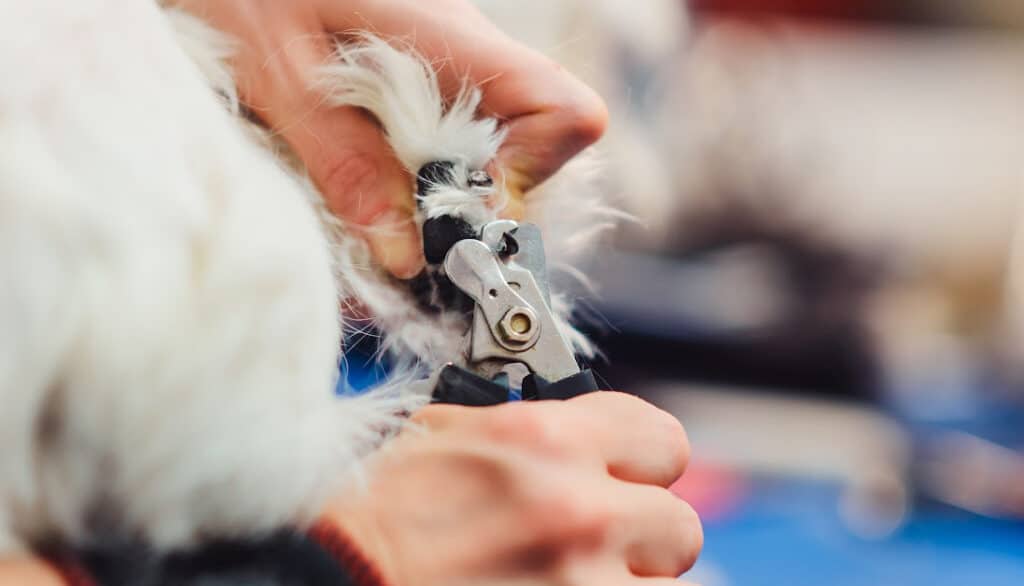
Limited to Nail’s Shape
- Curve Challenges: For dogs with especially curved nails, getting a clean cut without pinching can be tricky.
- Requires Re-positioning: Unlike grinders that can be used at various angles, clippers often require you to reposition for the best angle, which can be challenging if your dog is fidgety.
Wear and Tear
- Blunt Blades: Over time, the blades can become dull, leading to imprecise cuts or requiring more force.
- Maintenance Needed: To keep them in top shape, clippers need occasional cleaning and might require blade replacements.
Can be Intimidating
- Initial Fear: The “snapping” sound of the clip can be startling for some dogs, making them nervous about future grooming sessions.
- Owner Anxiety: For many pet parents, the fear of hurting their pet can make using clippers a nerve-wracking experience.
While these drawbacks might give you pause, remember that with knowledge, patience, and a bit of practice, many of these challenges can be managed. It’s always essential to weigh the pros and cons and consider both your comfort level and your dog’s temperament when choosing a grooming tool. After all, our main goal is always a happy, healthy pup with perfectly pampered paws! 🐾✂️🐶
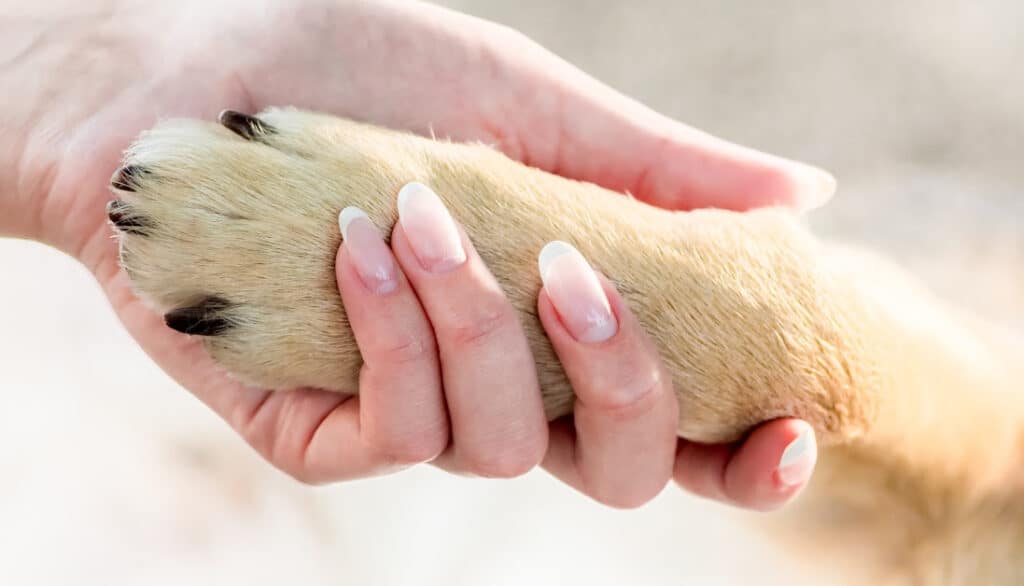
Factors to Consider When Choosing Between Grinder and Clipper
Stepping into the world of dog nail grooming can feel a bit like being a kid in a candy store. With shiny tools and gadgets promising the world, how do you pick the best treat for your pup? To make this decision a tad easier, here are some factors to mull over when torn between grinders and clippers.
Your Dog’s Temperament
- Noise Sensitivity: If your dog gets spooked by noises, the hum of a grinder might be unsettling. In contrast, the quick snip of clippers might be preferable.
- Patience Levels: Some dogs might not have the patience for the gradual process of grinding, preferring the swiftness of clipping.
Nail Thickness and Shape
- Hardy Nails: Grinders might be better suited for dogs with especially thick nails, as they can handle the density more effectively.
- Curve Concerns: If your dog has very curved nails, using clippers might require more finesse, whereas a grinder can adapt to different angles.
Your Skill and Comfort Level
- Experience: If you’re new to dog nail grooming, you might find one tool more intuitive than the other. Consider which one you’re more comfortable handling.
- Control: Grinders offer more control in terms of slowly approaching the desired nail length, whereas clippers require a more precise judgment.
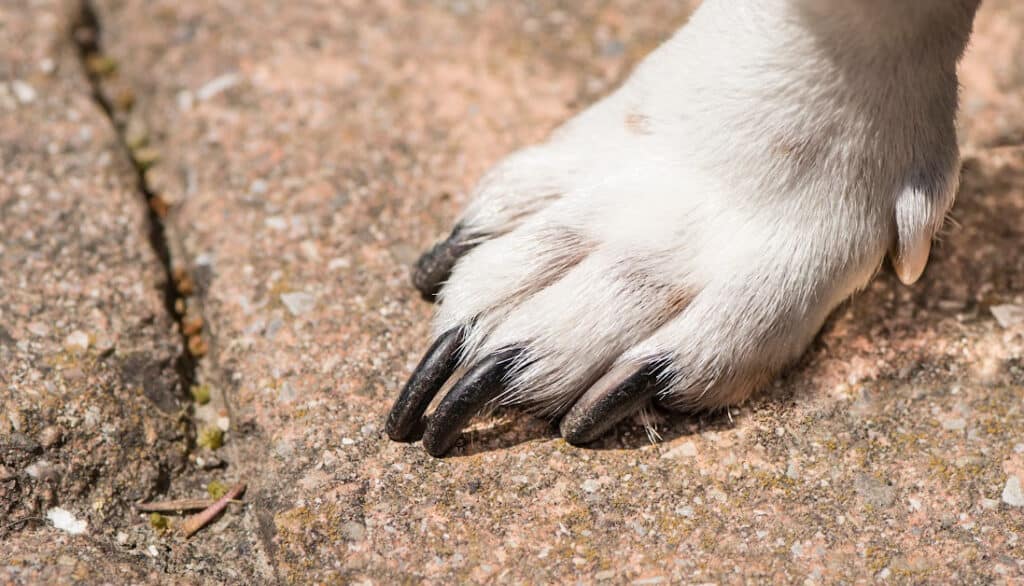
Maintenance and Upkeep
- Ongoing Costs: Grinders might need new bands or heads over time, and battery-operated ones will need charging or new batteries. Clippers might require occasional blade sharpening or replacement.
- Cleaning and Care: Think about how willing you are to maintain and clean your tool. Clippers might need less upkeep compared to grinders, which can get clogged with nail dust.
Frequency of Use
- Regular Grooming: If you plan to trim your dog’s nails frequently, you might want a tool that’s quick and easy to use, aligning more with clippers.
- Occasional Trimming: If you’re only doing occasional trims and prioritize a smooth finish, a grinder might be your pick.
Budget
- Initial Investment: Grinders can be pricier upfront, but they might save you money in the long run if you’re avoiding professional grooming services.
- Value for Money: Clippers are generally more affordable and can last a long time if cared for properly.
Deciding between a grinder and a clipper isn’t a one-size-fits-all situation. It’s more of a tailored suit – you’ve got to find the right fit for both you and your pup. Keep these factors in mind, perhaps even test both tools, and soon enough, you’ll find your groove in the grooming game. Happy grooming! 🐕🛍️🐾

Conclusion
Navigating the world of dog nail grooming can sometimes feel like a balancing act on a tightrope—with our precious pooches waiting on the other side. But armed with knowledge and a sprinkle of patience, finding the right tool doesn’t have to be a circus act.
Whether you gravitate towards the futuristic hum of the grinder or find solace in the traditional snap of the clippers, remember that the heart of the matter is the well-being and comfort of your furry friend. There’s no ‘one-size-fits-all’ in this story. Every dog is unique, and what works for one might send another running for the hills (or under the bed).
So, as you embark on this grooming journey, embrace the stumbles, celebrate the victories (however tiny they might be), and always trust your instinct. After all, no one knows your canine companion better than you do.
In the end, it’s not just about perfectly manicured paws but about the loving bond that grows with each grooming session. Because when those tail wags and happy barks fill the room, you’ll know you’ve made the right choice. Here’s to many more days of prancing paws, cuddles, and the joyous journey of pet parenthood. Until next time, keep those tails wagging and nails snazzy! 🐾❤️🎉
Frequently Asked Questions
A: Typically, a dog’s nails should be trimmed every 3-4 weeks. However, this can vary based on the dog’s activity level, age, and nail growth rate. Regularly check your dog’s nails, and if you hear them clicking on the floor, it’s probably time for a trim.
A: Absolutely! It might take some time for your dog to adjust to the new sensation and sound. It’s essential to introduce the grinder slowly, allowing your dog to get accustomed to its noise and vibration. Start with short sessions and reward your dog generously to make it a positive experience.
A: First, don’t panic. It can be distressing for both you and your dog, but it’s a common mistake. Have styptic powder or pen on hand, which helps stop the bleeding and alleviate pain. If bleeding continues for more than a few minutes, consult your vet.
A: Yes, regular maintenance ensures that the tool functions effectively and is safe for your pet. For grinders, remove nail dust and check the grinding band or stone for wear. Clippers should be checked for sharpness and cleaned to avoid any bacterial buildup.
A: Gradual desensitization is key. Start by letting your dog inspect the tool without using it. Reward them with treats and praise for calm behavior. Over time, work up to short grooming sessions, always pairing the experience with positive reinforcement. If anxiety continues, consider seeking advice from a professional dog groomer or trainer.
